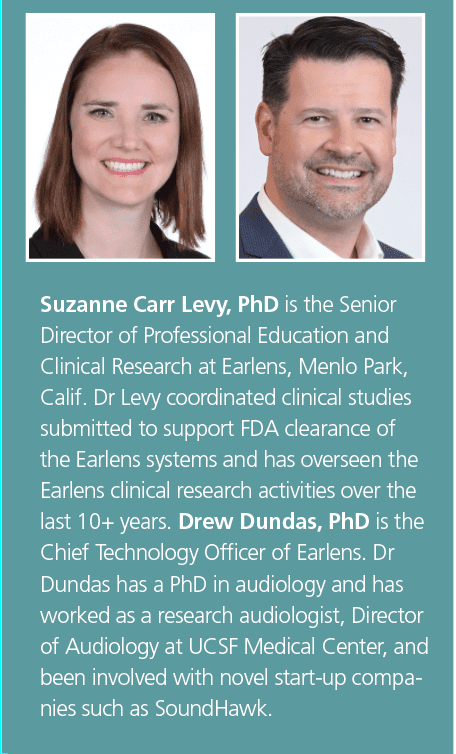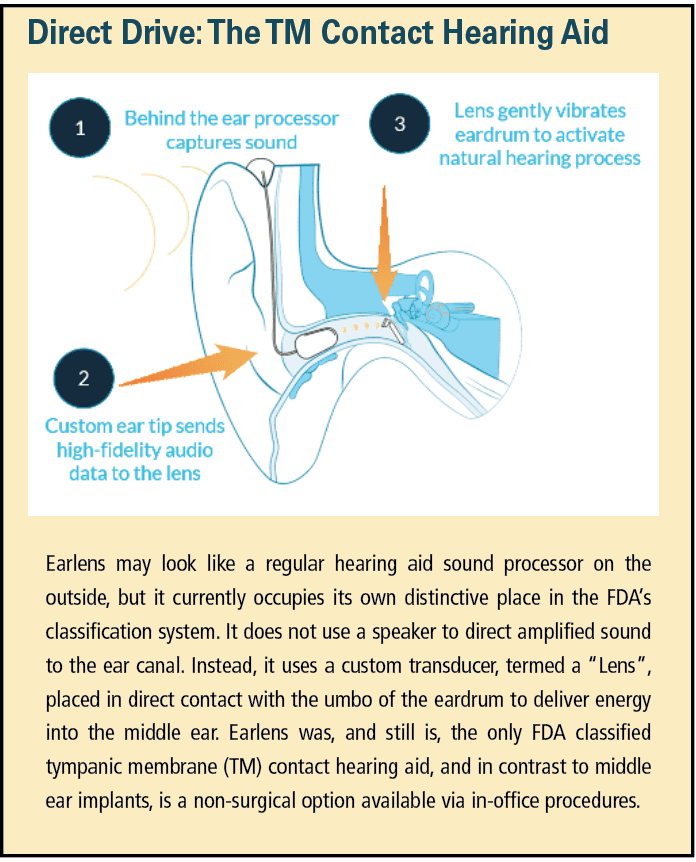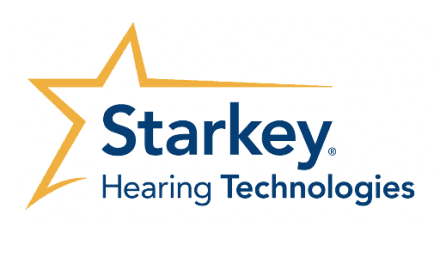Tech Topic | December 2021 Hearing Review
Part 1: Research on speech-in-noise and the pursuit of hearing care’s “Holy Grail”
By Suzanne Carr Levy, PhD, and Drew Dundas, PhD
This 3-part series serves as a high-level review of the data that has accumulated over the course of more than 10 years of clinical research with the Earlens system. Part 1 dives into the speech understanding data and how increasing the bandwidth of processed sound in Earlens results in improved speech understanding from a number of perspectives. Part 2 will discuss the perceptual benefits to naturalness and overall sound quality. Finally, Part 3 will explore how the research evidence can be explained in terms of the restoration of specific and overall loudness via the CAM2HF fitting algorithm, and how this approach to overall audibility improvement is reliably achieved in Earlens fittings via direct drive.
If you’ve heard of “Earlens,” you’ve probably heard it described as a non-acoustic hearing solution that promises unprecedented audibility, sound quality, and performance. You’ve probably also wondered when you might hear more about the evidence behind those claims. The fundamental premise of Earlens is to provide a broader bandwidth of audibility for speech and other sounds for individuals with mild to severe sensorineural hearing loss. This improvement in audibility was assumed to be the foundation of a better listening experience—especially in noisy and challenging listening environments.
Although this hypothesis had been supported by headphone-based research, whether it would translate into on-ear, real-world benefit remained to be proven when this novel device was first imagined. With the company now expanding the commercial rollout of the second generation of the Earlens device, has the promise been fulfilled?
Early testimonials by Earlens patients described subjectively superior listening experiences in terms of sound quality, clarity, and speech understanding. Today, the objective clinical evidence gathered over roughly a 10-year period of time clearly demonstrates the difference in audible or “supra-threshold” bandwidth that can be achieved via the direct drive technology of the Earlens system.
Furthermore, the results confirm the hypothesis that broadband audibility matters —delivering key advantages in subjective preference, perceived sound quality, objective speech recognition (including words in quiet, consonant recognition and word-final /s/ detection), and the “Holy Grail” of hearing aids: a clear benefit in speech understanding in a complex environment of competing speech maskers. In fact, data has now been published demonstrating a clear audible bandwidth advantage both by artificially band-limiting audibility within the Earlens device, as well as by comparing performance head-to-head with acoustic hearing aids fit to validated prescriptive targets.
Overcoming Limitations to Making Speech Audible
The main value proposition of Earlens from a clinical evidence perspective is the achievement of broad-spectrum audibility for speech in listeners with a broad range of sensorineural hearing impairments (see sidebar).1 The device provides an average of 120 dB SPL of output and up to 60 dB of insertion gain through 10,000 Hz, while simultaneously providing amplification extending below 100 Hz even with a widely vented fitting. Earlens’ unique performance is achieved by directly vibrating the umbo of the tympanic membrane. The power transfer efficiency advantage of coupling the “receiver” directly to the middle ear overcomes both low-frequency venting losses and the high-frequency roll-off characteristic of acoustic receivers, while the lack of acoustic feedback allows for the provision of substantial gain in the very high frequencies.
The combination of high stable gain with high maximum output is necessary to make high frequency speech audible above approximately 5 kHz for a typical sloping hearing loss. In contrast, the trade-off challenges that acoustic technology battles in terms of balancing output versus power consumption, gain versus feedback, and venting versus occlusion effectively limit high frequency audibility of about 5 kHz for this population, even for well-fit verified devices.
If you don’t believe us, look at your real-ear measurement system the next time you measure the maximum output sweep on an acoustic device that claims bandwidth to 10 kHz; in regions where the “MPO” response curve dips below threshold, nothing passing through the hearing aid in that frequency region is audible even if there is some nominal insertion gain applied (see the April 2021 Hearing Review article by Mueller et al that demonstrates the MPO roll-off of acoustic devices for a typical sloping hearing loss2). With direct-drive technology, the high frequency maximum output does not roll off at frequencies above the receiver peak output, and the increasing drive efficiency at higher frequencies means that the system is capable of providing the maximum output necessary to allow the application of 50-60 dB of insertion gain to the speech signal in the 5-10 kHz region.
Hypothetical Benefits to Speech Understanding Due to Broader Audibility
Broader audible bandwidth above 5 kHz should translate into improved speech understanding by allowing detection of the low-energy consonant sounds in that region, and in turn should extend to better speech understanding in noisy and complicated environments due to increased signal redundancy. Given that the fundamental premise of audiologic rehabilitation is the restoration of audibility, it follows that you’d expect better performance compared to acoustic hearing aids where audibility is more limited. Without an alternative to acoustic devices, clinicians are often left to “give up” on achieving audibility above 5 kHz for those with more than mild loss. In fact, hearing care professionals commonly refer to 4 kHz as a “high-frequency” sound, while the general audio world would certainly call this a “mid-frequency” sound. If you were suddenly able to easily provide high-frequency audibility with a different type of device, how much more speech understanding performance benefit would you expect to see?
Parts-of-Speech Outcomes
One of the challenges we have faced when comparing Earlens technology head-to-head with acoustic devices is that it is not easy to blind participants to the technology they are using. In order to achieve double blinding of participants and researchers, it is simpler to explore the effects of limiting bandwidth to 5 kHz within the Earlens device itself to replicate the bandwidth of an acoustic device. When comparing performance between the limited (5 kHz) bandwidth condition and the full (10 kHz) bandwidth condition as in the recent research published by Folkeard et al,3 significant improvements in consonant recognition in noise and word-final /s/ detection were noted. Expected confusion patterns for phonemes with higher frequency content were seen in the limited bandwidth condition (eg, /s/ for /f/, /z/ for /v/, and /t/ for /k/) and absolute consonant recognition performance. Additionally, the ability to distinguish plurals was significantly better in the full bandwidth condition with an average plural detection performance of over 90%.
These findings confirm that supra-threshold and useful audibility of speech sounds in the expected frequency regions occurs with the Earlens system. Said another way, patients with up to severe sensorineural high frequency losses can not only hear, but also make use of, high frequency audibility to recognize high frequency consonant sounds more accurately—in the frequency regions they belong in and without any need for frequency-lowering technologies.
Effect of Audible Bandwidth on Speech Understanding in Noise
Prior to fitting the first Earlens in a feasibility study, the implementation of the signal processing and CAM2 algorithm were tested acoustically in hearing-impaired users via binaural sealed insert earphones, and the Hearing in Speech Test (HIST) study paradigm was used to investigate the effects of bandwidth on speech understanding.4 An asymmetric test condition was employed in the HIST, with two masking talkers 45° to one side and the target talker 45° to the contralateral side. This setup creates a long-term SNR advantage in one ear (particularly in the high frequencies where the masker’s high-frequency consonants are shadowed at the “better ear” facing the target). The results in hearing-impaired listeners showed that SNR performance improved by the equivalent of over 30% as bandwidth increased from 4 to 10 kHz, demonstrating a significant advantage when provided with extended audible bandwidth.
Folkeard et al3 replicated the SNR performance advantage findings of Levy et al4 in a double-blinded study using the Earlens devices in band-limited versus full-bandwidth conditions. The authors showed that Earlens users performed significantly better on a speech-in-speech task with full 10 kHz bandwidth versus limited 5 kHz bandwidth. (The 5 kHz bandwidth condition approximates the maximum audible output frequency (MAOF) of the as-fit acoustic aids worn by the participants at the time of enrollment in the study).
While that study was progressing, in our own research lab we revised the HIST from an adaptive SNR paradigm to a more ecologically relevant percent-correct paradigm that measured the increase in performance at the same SNR when the bandwidth was increased from 5 kHz to 10 kHz. A similar effect size was observed to Folkeard et al, with significant improvements in speech understanding achieved in the full-bandwidth condition. Combined, these studies demonstrate that the extended audible bandwidth provided via Earlens direct drive does indeed improve speech understanding performance at supra-threshold levels and in a complex speech-in-noise task.
Speech Understanding in Noise Compared to Acoustic Hearing Aids
For 10 years now, we have heard: “We want to see objective evidence showing that Earlens is better than acoustic technology for speech understanding in noise; if it’s all audibility and not signal processing, then you should be able to measure that.” Recently, we have been working on this last building block of evidence: a direct comparison of the full Earlens bandwidth to acoustic hearing aids fit to NAL-NL2 targets. Pilot research was presented at the 2021 American Academy of Audiology convention5 and described a test paradigm where the SNR for 50% correct performance was established via an adaptive task while wearing acoustic hearing aids fit and verified to NAL-NL2 targets via clinical best practices.5 Analysis of the real-ear fitting data for the premium air-conduction hearing aids demonstrated that there was no audibility for speech above 5-6 kHz for the target stimuli even when fit to target. A full set of HIST sentences were then administered at the SNR 50%, and the average percent-correct score was collected. When these same participants were fit with Earlens, the effective bandwidth was 10 kHz, and the participants repeated the HIST test at the same SNR. With Earlens, participants achieved an average of almost a 30% increase in performance in background noise—which is a subjectively life-changing result for most hearing aid users.
Also of interest, every participant demonstrated improved performance on this test paradigm when fit with Earlens. We intend to extend this research to include additional models of competitive devices and sites, although even this early work is very compelling. Further, we encourage audiologists who fit Earlens to perform objective assessments—such as aided soundfield testing, NU-6, and QuickSIN—head-to-head with acoustic devices in their own clinics to demonstrate the performance advantage to themselves and their patients.
Summary
Ten years ago, we set out to answer the question, “Will people actually hear speech better with the Earlens device?” The answer is a resounding yes. Indeed, hearing-impaired users are able to make use of the extended range of audible speech information to understand more parts of speech. This subsequently translates into improvement in speech understanding in complex environments—the so-called “Holy Grail” of hearing aid technology benefit.
The Earlens device has the potential to benefit many people and provide clinicians with a technology offering that is not only highly differentiated from conventional devices, but also provides superior speech understanding outcomes. In Parts 2 and 3 of this series, we will explore evidence that answers the questions, “How does it sound, and will patients like it?” and, “What does this mean more broadly, and who is Earlens good for?”

CORRESPONDENCE can be addressed to Dr Levy at: [email protected].
Citation for this article: Levy SC, Dundas D. A 10-year review of the Earlens System. Hearing Review. 2021;28(12)14-16.
Other articles in this series:
- A 10-Year Review of the Earlens System, Part 2: Direct Drive: Sound Quality and Preference Evidence (Jan 2022 HR, pgs 14-15)
- A 10-Year Review of the Earlens System, Part 3: What’s the Big Deal about Audibility and Broader Audible Bandwidth? (Feb 2022 HR, pgs 24-27)
References
- Dundas D, Levy SC. Earlens Contact Hearing Solution introduced with inductive coupling vs light-driven coupling. Hearing Review. 2020;27(4):28-30.
- Mueller HG, Stangl E, Wu Y-H. Comparing MPOs from six different hearing aid manufacturers: Headroom considerations. Hearing Review. 2021;28(4):10-16.
- Folkeard P, Eeckhoutte MV, Levy S, et al. Detection, speech recognition, loudness, and preference outcomes with a direct drive hearing aid: Effects of bandwidth. Trends in Hearing. 2021;25:1-17
- Levy SC, Freed DJ, Nilsson M, Moore BCJ, Puria S. Extended high-frequency bandwidth improves speech reception in the presence of spatially separated masking speech. Ear Hear. 2015:36(5):e214–e224.
- Vasuki PRM, Levy SPC, Dundas D. Extended High-Frequency Audibility via Direct Drive Improves Speech Understanding in Noise. Paper presented at: The 2021 American Academy of Audiology (AAA) + HearTECH Expo; April 14-16, 2021; virtual.





